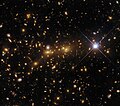File:Galactic monster mash (potw2328a).tiff
From Wikimedia Commons, the free media repository
Jump to navigation
Jump to search

Size of this JPG preview of this TIF file: 677 × 600 pixels. Other resolutions: 271 × 240 pixels | 542 × 480 pixels | 867 × 768 pixels | 1,156 × 1,024 pixels | 2,311 × 2,048 pixels | 3,556 × 3,151 pixels.
Original file (3,556 × 3,151 pixels, file size: 64.16 MB, MIME type: image/tiff)
File information
Structured data
Captions
Captions
The NASA/ESA Hubble Space Telescope has captured a monster in the making in this observation of the exceptional galaxy cluster eMACS J1353.7+4329, which lies about eight billion light-years from Earth in the constellation Canes Venatici.
Summary[edit]
| DescriptionGalactic monster mash (potw2328a).tiff |
English: The NASA/ESA Hubble Space Telescope has captured a monster in the making in this observation of the exceptional galaxy cluster eMACS J1353.7+4329, which lies about eight billion light-years from Earth in the constellation Canes Venatici. This disturbed collection of at least two galaxy clusters is in the process of merging together to create a cosmic monster, a single gargantuan cluster acting as a gravitational lens.Gravitational lensing is a dramatic example of Einstein’s general theory of relativity in action. A celestial body such as a galaxy cluster is sufficiently massive to distort spacetime, which causes the path of light around the object to be visibly bent as if by a vast lens. Gravitational lensing can also magnify distant objects, allowing astronomers to observe objects that would otherwise be too faint and too far away to be detected. It can also distort the images of background galaxies, turning them into streaks of light. The first hints of gravitational lensing are already visible in this image as bright arcs which mingle with the throng of galaxies in eMACS J1353.7+4329.The data in this image are drawn from an observing proposal called Monsters in the Making, which used two of Hubble’s instruments to observe five exceptional galaxy clusters at multiple wavelengths. These multi-wavelength observations were made possible by Hubble’s Wide Field Camera 3 and Advanced Camera for Surveys. The astronomers behind these observations hope to lay the groundwork for future studies of vast gravitational lenses with next-generation telescopes such as the NASA/ESA/CSA James Webb Space Telescope.[Image Description: A cluster of elliptical galaxies, visible as a dense crowd of oval shapes, each glowing orange around a bright core. Right of the largest, central galaxy, a background galaxy is stretched into two connected, thin arcs by the cluster’s gravity. Various other galaxies are dotted all around, a few being small spirals. A bright star with four long spikes stands out at the right.] |
| Date | 10 July 2023 (upload date) |
| Source | Galactic monster mash |
| Author | ESA/Hubble & NASA, H. Ebeling |
| Other versions |
|
Licensing[edit]
| ESA/Hubble images, videos and web texts are released by the ESA under the Creative Commons Attribution 4.0 International license and may on a non-exclusive basis be reproduced without fee provided they are clearly and visibly credited. Detailed conditions are below; see the ESA copyright statement for full information. For images created by NASA or on the hubblesite.org website, or for ESA/Hubble images on the esahubble.org site before 2009, use the {{PD-Hubble}} tag.
Conditions:
Notes:
|
This file is licensed under the Creative Commons Attribution 4.0 International license.
Attribution: ESA/Hubble
- You are free:
- to share – to copy, distribute and transmit the work
- to remix – to adapt the work
- Under the following conditions:
- attribution – You must give appropriate credit, provide a link to the license, and indicate if changes were made. You may do so in any reasonable manner, but not in any way that suggests the licensor endorses you or your use.
File history
Click on a date/time to view the file as it appeared at that time.
| Date/Time | Thumbnail | Dimensions | User | Comment | |
|---|---|---|---|---|---|
| current | 09:00, 10 July 2023 |  | 3,556 × 3,151 (64.16 MB) | OptimusPrimeBot (talk | contribs) | #Spacemedia - Upload of https://esahubble.org/media/archives/images/original/potw2328a.tif via Commons:Spacemedia |
You cannot overwrite this file.
File usage on Commons
The following page uses this file:
Metadata
This file contains additional information such as Exif metadata which may have been added by the digital camera, scanner, or software program used to create or digitize it. If the file has been modified from its original state, some details such as the timestamp may not fully reflect those of the original file. The timestamp is only as accurate as the clock in the camera, and it may be completely wrong.
| Width | 3,556 px |
|---|---|
| Height | 3,151 px |
| Bits per component |
|
| Compression scheme | Uncompressed |
| Pixel composition | RGB |
| Image data location | 34,610 |
| Orientation | Normal |
| Number of components | 3 |
| Number of rows per strip | 3,151 |
| Bytes per compressed strip | 67,229,736 |
| Horizontal resolution | 25.4 dpi |
| Vertical resolution | 25.4 dpi |
| Data arrangement | chunky format |
| Software used | Adobe Photoshop 24.4 (Windows) |
| File change date and time | 15:46, 5 July 2023 |
| Color space | Uncalibrated |


